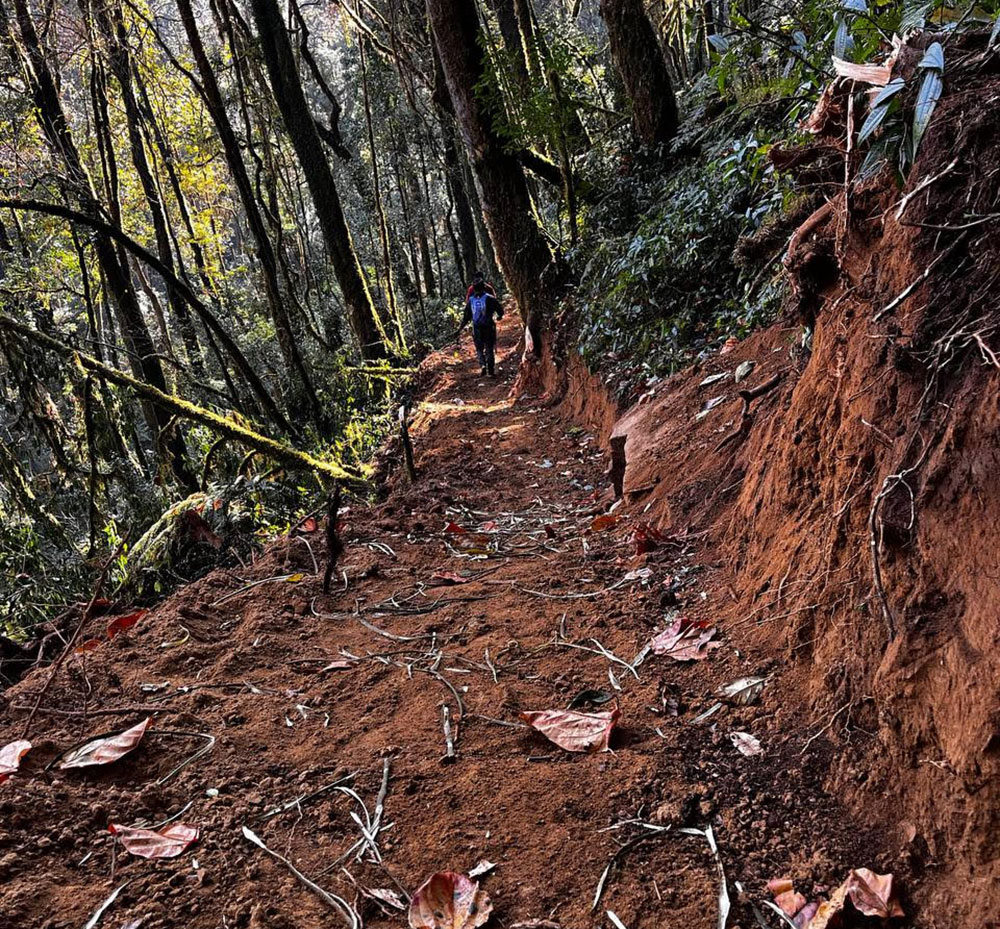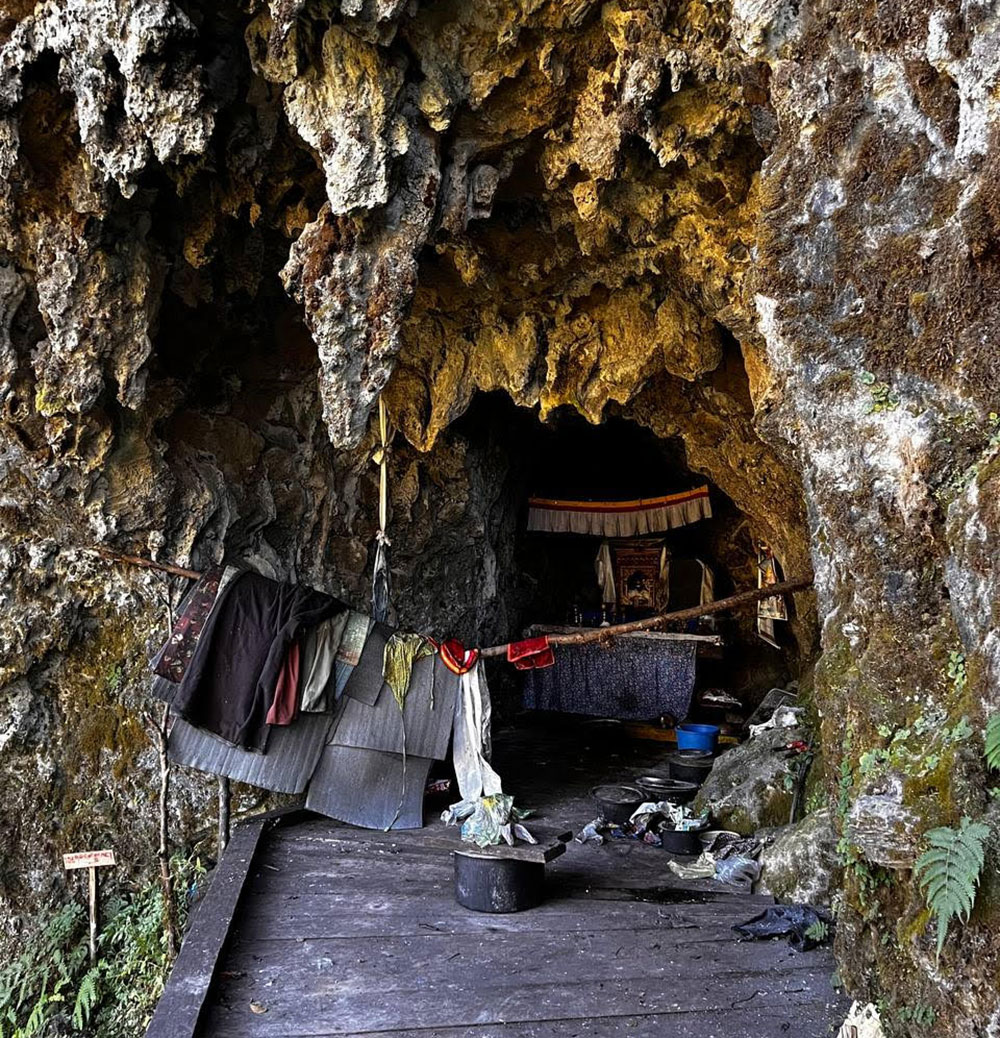Chencho Dema
Punakha—The 13-kilometre eco-trail from Tamidamchu in Toedwang Gewog to Ugyenphu Ney in Punakha is not just a path through nature; it’s an immersive journey into the heart of Bhutan’s pristine wilderness, offering hikers a serene escape from the chaos of daily life.
As adventurers delve deeper into the dense forest, they are greeted by a symphony of sights, scents, and sounds. The air is infused with the earthy fragrance of moss and ferns, while the gentle rustle of leaves provides a melodic backdrop to the hike.
Amidst the lush foliage, hikers encounter a vibrant flora and fauna, from delicate wildflowers to elusive wildlife. The trail meanders gracefully, revealing hidden clearings that unveil panoramic views of the surrounding landscape, offering moments of awe and contemplation.

After hours of exploration, the trail culminates in a remarkable discovery: Ugyenphu Ney, a sacred cave nestled amidst the mountains. Steeped in history and spirituality, this ancient sanctuary beckons weary travelers with its tranquil ambiance and timeless allure.
Here, amidst the hallowed halls of the ney, hikers find solace and rejuvenation. Whether pausing for reflection, meditation, or simply to bask in the serenity of the surroundings, each moment spent in this sacred space is a testament to the power of nature to nourish the soul.
Beyond its natural beauty, the eco-trail holds promise for the local community, offering economic opportunities and attracting visitors eager to experience its wonders firsthand. As word spreads of this hidden gem, the gewog stands poised to benefit from increased tourism and the preservation of its natural heritage.
In traversing the Tamidamchu to Ugyenphu Ney eco-trail, hikers embark on a transformative journey—one that nourishes the spirit, fosters connection with the land, and leaves an indelible mark on the soul.
Brief history
The Ney is revered as a clandestine sanctuary of Guru Rimpoche, steeped in mystique and ancient lore. Although its origins remain shrouded in mystery, its sacred aura has long been acknowledged by the residents of Toedwang Gewog.
While the annals of history remain silent on its genesis, the Ney’s sanctity echoes through the whispers of time, resonating with the unwavering faith of generations past. According to local lore, its significance predates written records, attesting to its enduring presence in the collective consciousness of the community.
In the digital age, glimpses of its importance surface, with online sources hinting at its revered status as a repository of hidden treasures, as referenced in petition prayers to Lingmukha Genyen. This enigmatic site holds a revered position among the sacred sites of Guru Rinpoche, serving as a beacon of spiritual enlightenment and divine connection for believers near and far.
Ugyenphu Ney stands as a distinguished pilgrimage site within the revered circuit of Druk Neykor. The journey to its sacred grounds has been made more accessible with the completion of an eco-trail, a testament to the commitment to preserving both its sanctity and the surrounding environment.
Initiated in July 2022 and meticulously crafted through phased stages, this eco-trail project reached fruition in December 2023, marking a milestone in the region’s efforts towards sustainable tourism. The inaugural phase concluded in May 2023, opening doors to a realm where spiritual devotion and ecological harmony intertwine.
The Department of Tourism (DoT) contributed significantly to this endeavor, providing Nu 2.6 million in funding. Under the watchful guidance of the Punakha Dzongkhag and Toedwang Gewog Administration, the project took shape, blending modern infrastructure with the timeless essence of the Ney’s spiritual aura.
As custodians of this precious heritage, the Dzongkhag and Gewog are poised to establish a committee tasked with the stewardship of the trail. This collaborative effort ensures the sustainable management of the Ney’s surroundings, safeguarding its cultural significance for future generations.
Yeshi Dorji, the Economic Development Officer, underscores the cultural importance of the Ney and emphasizes the imperative for diversifying the Gewog’s revenue streams. Beyond its spiritual resonance, the Ney holds the potential to serve as a catalyst for economic growth, offering opportunities for sustainable development while honoring the traditions of the land.
Yeshi Dorji also expressed confidence that the completion of the eco-trail will encourage more locals to embark on hikes to the Ney, and he remains optimistic that tourists will also discover the trail. He remarked, “Previously, due to the limited access to the Ney, few people dared to attempt the hike, but I anticipate a rise in visitors now.”
Yeshi Dorji also expressed his belief that the completion of the eco-trail will attract more local residents to embark on hikes to the Ney, and he remains optimistic that tourists will also explore the trail.
He said, “In the past, due to the limited access to the Ney, not many people attempted the hike, but I hope that there will be an increase in visitors.”
According to him, the hike is considered moderate, taking about eight hours to complete, with a shorter duration for the return journey. Basic amenities have been set up along the trail for hikers’ convenience, including toilets, drinking water pipes, and benches with tables for resting when tired.
For those wishing to spend the night, the Ney offers an open wooden plank adjacent to the site, capable of accommodating more than 30 people. However, individuals need to bring their own sleeping bags and blankets for added comfort during their stay.
The ideal seasons for hiking to the Ney are from October to December and February to March. However, it is not advisable to hike during the monsoon season due to unfavorable weather conditions.
Punakha is renowned for its many sacred pilgrimage sites spread across the dzongkhag, including Goen Tshephu, Nangsel Goenpa, and Ugyenphu Ney, to name a few.


